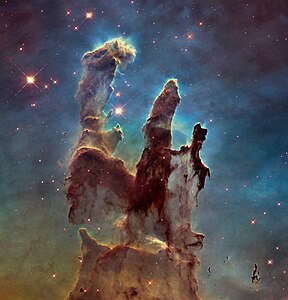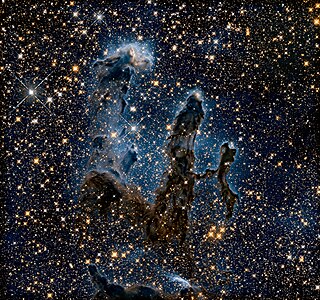Pillars of Creation
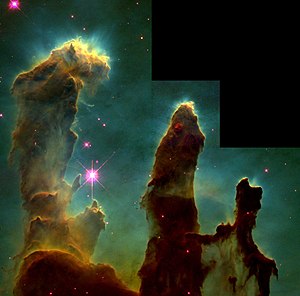
(animation; 0:15; 11 November 2022)
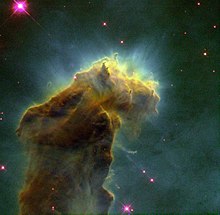
Pillars of Creation is a photograph taken by the Hubble Space Telescope of elephant trunks of interstellar gas and dust in the Eagle Nebula, in the Serpens constellation, some 6,500–7,000 light-years (2,000–2,100 pc; 61–66 Em) from Earth.[1] These elephant trunks had been discovered by John Charles Duncan in 1920 on a plate made with the Mount Wilson Observatory 60-inch telescope.[2][3] They are so named because the gas and dust are in the process of creating new stars, while also being eroded by the light from nearby stars that have recently formed.[4]
Taken on April 1, 1995, it was named one of the top ten photographs from Hubble by Space.com.[5] The astronomers responsible for the photo were Jeff Hester and Paul Scowen from Arizona State University. The region was rephotographed by ESA's Herschel Space Observatory in 2011, again by Hubble in 2014 with a newer camera, and the James Webb Space Telescope in 2022.
Released in 2007, Chandra X-ray Observatory (AXAF) had observed the area in 2001. It did not find many X-ray sources in the towers but was able to observe sources at various X-ray energy levels in the area from young stars.[6]
The image is noted for its global culture impact, with National Geographic noting on its 20th anniversary that the image had been featured on everything from "t-shirts to coffee-mugs".[7]
Name[edit]
The name is based on a phrase used by Charles Spurgeon in his 1857 sermon "The Condescension of Christ":[8]
In calling the Hubble's spectacular new image of the Eagle Nebula the Pillars of Creation, NASA scientists were tapping a rich symbolic tradition with centuries of meaning, bringing it into the modern age. As much as we associate pillars with the classical temples of Greece and Rome, the concept of the pillars of creation – the very foundations that hold up the world and all that is in it – reverberates significantly in the Christian tradition. When William Jennings Bryan published The World's Famous Orations in 1906, he included an 1857 sermon by London pastor Charles Haddon Spurgeon titled "The Condescension of Christ". In it, Spurgeon uses the phrase to convey not only the physical world but also the force that keeps it all together, emanating from the divine: "And now wonder, ye angels," Spurgeon says of the birth of Christ, "the Infinite has become an infant; he, upon whose shoulders the universe doth hang, hangs at his mother's breast; He who created all things, and bears up the pillars of creation, hath now become so weak, that He must be carried by a woman!"
Composition[edit]
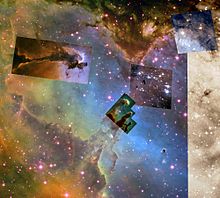
The pillars are composed of cool molecular hydrogen and dust that are being eroded by photoevaporation from the ultraviolet light of relatively close and hot stars. The leftmost pillar is about four light-years in length.[9] The finger-like protrusions at the top of the clouds are larger than the Solar System, and are made visible by the shadows of evaporating gaseous globules (EGGs), which shield the gas behind them from intense UV flux.[10] EGGs are themselves incubators of new stars.[11] The stars then emerge from the EGGs, which then are evaporated.
Theorized destruction[edit]
Images taken with the Spitzer Space Telescope uncovered a cloud of dust in the vicinity of the Pillars of Creation that hypothetically could be a shock wave produced by a supernova.[12] The appearance of the cloud suggests the supernova shockwave would have destroyed the Pillars of Creation 6,000 years ago. Given the distance of roughly 7,000 light-years between Earth and the Pillars of Creation, this would mean that they have actually already been destroyed, but because light travels at a finite speed, this destruction should be visible from Earth in about 1,000 years.[13]
This interpretation of the hot dust has been disputed by an astronomer uninvolved in the Spitzer observations, who argues that a supernova should have resulted in stronger radio and x-ray radiation than has been observed, and that winds from massive stars could instead have heated the dust. If this is the case, the Pillars of Creation will undergo a more gradual erosion.[14]
Photographs[edit]
Original Hubble Space Telescope photo[edit]
Hubble's photo of the pillars is composed of 32 different images[15] from four CCD images[16] in the Wide Field and Planetary Camera 2 on board Hubble.[17] The photograph was made with light emitted by different elements in the cloud and appears as a different color in the composite image: green for hydrogen, red for singly ionized sulfur and blue for double-ionized oxygen atoms.[4]
The "stair-shaped"[16] missing part of the picture at the top right corner originates from the fact that the camera for the top-right quadrant has a magnified view; when its images are scaled down to match the other three cameras, there is necessarily a gap in the rest of that quadrant.[16] This effect is also present on other WFPC2 images, and can be displayed at any corner depending on how the image has been re-oriented for publication.[18]
The Wide Field and Planetary Camera 2 was replaced by the Wide Field Camera 3, and the former was taken back to Earth where it is displayed in a museum. It was replaced in 2009 as part of a Space Shuttle mission (STS-125).
Herschel's photo[edit]
In 2010 Herschel Space Observatory captured a new image of the Pillars of Creation in far-infrared wavelengths, which allows astronomers to look inside the pillars and structures in the region, and come to a much fuller understanding of the creative and destructive forces inside the Eagle Nebula.[19]
Revisits[edit]
In celebration of the 25th anniversary since the launch of the Hubble Space Telescope, astronomers assembled a larger and higher-resolution photograph of the Pillars of Creation which was unveiled in January 2015 at the American Astronomical Society meeting in Seattle. The image was photographed by the Hubble Telescope's Wide Field Camera 3, installed in 2009, in visible light. An infrared image was also taken.[20] The re-imaging has a wider view that shows more of the base of the nebulous columns.[7]
In October 2022, it was unveiled that the James Webb Space Telescope captured a new image of the Pillars of Creation utilizing the NIRCam aboard the spacecraft. The image was able to capture ejections from the formation of young stars still in development in great detail, as seen by the red spots near the edges of the pillars.[21][22]
-
A higher-resolution Hubble Space Telescope image of the Pillars of Creation, taken in 2014 as a tribute to the original photograph
-
Infrared image taken by the Hubble Space Telescope in 2014
-
Near-infrared taken by the James Webb Space Telescope in 2022
-
JWST's mid-infrared view of the Pillars of Creation, 2022
See also[edit]
References[edit]
- ^ Clavin, Whitney. "'Elephant Trunks' in Space". Archived from the original on February 5, 2023. Retrieved March 9, 2011.
- ^ Duncan, J. C. (1920). "Bright nebulae and star clusters in Sagittarius and Scutum photographed with the 60-inch reflector". The Astrophysical Journal. 51: 4. Bibcode:1920ApJ....51....4D. doi:10.1086/142519.
- ^ Oliveira, Joana M. (2008). Star Formation in the Eagle Nebula. arXiv:0809.3735. Bibcode:2008hsf2.book..599O.
- ^ a b Embryonic Stars Emerge from Interstellar "Eggs", Hubble news release
- ^ Best Hubble Space telescope images from Space.com. [archived copy]
- ^ "Chandra :: Photo Album :: The Eagle Nebula (M16) :: 15 Feb 07". chandra.harvard.edu. Retrieved September 17, 2019.
- ^ a b "Hubble Revisits an Icon, the Pillars of Creation". Science & Innovation. January 5, 2015. Archived from the original on August 4, 2020. Retrieved September 17, 2019.
- ^ Devorkin, David H.; Smith, Robert W. (2015). The Hubble Cosmos: 25 Years of New Vistas in Space. National Geographic Society. p. 67. ISBN 9781426215575.
- ^ "NOVA | Origins | The Pillars of Creation image 1". PBS. Retrieved February 13, 2012.
- ^ "The Birth of Stars". Csep10.phys.utk.edu. Retrieved February 13, 2012.
- ^ "A Stunning View Inside an Incubator for Stars – New York Times". The New York Times. November 3, 1995. Retrieved February 13, 2012.
- ^ Flagey, Nicholas; et al. (January 2009). "The Eagle Nebula Unveiled by the Spitzer/MIPSGAL Survey". Bulletin of the American Astronomical Society. 41 (1): 37. Bibcode:2009AAS...21332401F.
- ^ Lovett, Richard. "Photo in the News: Supernova Destroys "Pillars of Creation"". Archived from the original on January 12, 2007. Retrieved March 13, 2011.
- ^ Shiga, David (January 10, 2007). "'Pillars of creation' destroyed by supernova". Archived from the original on March 17, 2015. Retrieved May 4, 2012.
- ^ "NOVA | Origins | The Pillars of Creation image 3". PBS. Retrieved February 13, 2012.
- ^ a b c "NOVA | Origins | The Pillars of Creation image 2". PBS. Retrieved February 13, 2012.
- ^ "NOVA | Origins | The Pillars of Creation image 1". PBS. April 1, 1995. Retrieved February 13, 2012.
- ^ for example, this image of Seyfert's Sextet has the effect at bottom-left corner
- ^ "Revisiting the 'Pillars of Creation'". NASA. January 18, 2012. Archived from the original on September 10, 2019. Retrieved January 20, 2012.
- ^ "Hubble Goes High-Definition to Revisit Iconic 'Pillars of Creation'". NASA. January 5, 2015. Retrieved January 6, 2015.
- ^ Adkins, Jamie (October 18, 2022). "NASA's Webb Takes Star-Filled Portrait of Pillars of Creation". NASA. Retrieved October 19, 2022.
- ^ Overbye, Dennis (October 19, 2022). "Webb Telescope Captures New View of 'Pillars of Creation' - The NASA space observatory's infrared eye finds out what's going on within the cloudy cosmic nursery". The New York Times. Retrieved October 21, 2022.

